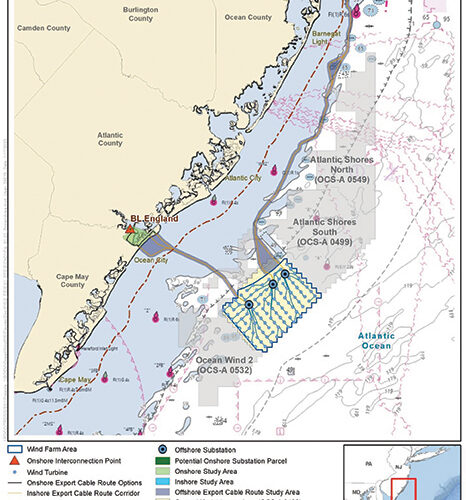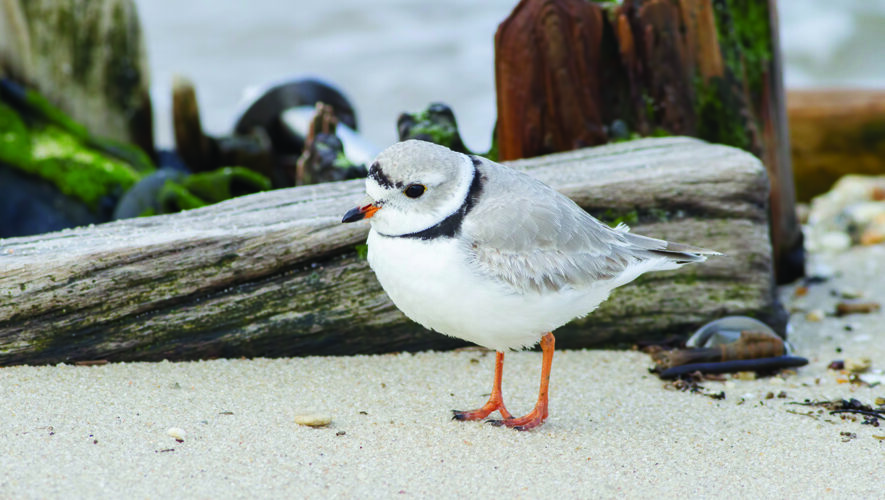FEIS assesses the effects on whales, tourism, skyline and much more
Editor’s note: See related letter from multiple groups to Ørsted’s CEO. The letter, with addendum, is available here.
OCEAN CITY — The federal Bureau of Ocean Energy Management’s Final Environmental Impact Statement (FEIS) on the Ocean Wind 1 offshore wind farm released Monday is another massive document.
Within the statement, BOEM assesses potential effects and labels them from negligible to major on things ranging from bats and sea turtles (negligible, minor) to North Atlantic right whales (moderate to major) to scenic and visual (major).
The FEIS, which is more than 2,300 pages, is another major step in the plan by Danish company Ørsted to build as many as 98 massive wind turbines off the coast of Atlantic and Cape May counties to produce 1,100 megawatts of electricity, part of Gov. Phil Murphy’s 2024 Energy Master Plan that sets a goal of 11,000 MW of power generated by offshore wind by 2040. (The Draft Environmental Impact Statement was more than 1,400 pages.)
Negligible to major impacts
The FEIS lists the effects ranging from negligible to major on a range of items.
The report says there will be minor to major effects on commercial fisheries and minor to moderate impacts on for-hire recreational fishing depending on the fishery or fishing operation.
It anticipates a moderate impact on navigation and vessel traffic and minor for most military and national security aspects, except for search and rescue activities, which it lists as moderate.
It does expect moderate to major impacts on scientific research and survey vessels.
The major impact on some fisheries and fishing operations “is primarily driven by regulated fishing effort and climate change because of the potential disruptions to fishing operations in the project area. The impacts … could also include long-term minor to moderate beneficial impacts for certain commercial fisheries and some for-hire recreational fishing operations due to the artificial reef effect.”
Proponents of the plan have noted artificial reefs would be formed around the bases of the monopiles that hold the wind turbines.
As whales and other marine mammals have been a major topic of concern, effects on the North Atlantic right whales are listed as moderate to major with a footnote showing for those whales to have “severe population-level effects and compromise the viability of the species due to their low” numbers. There are reported to be fewer than 350 North Atlantic right whales alive.
Over a period of a few months starting late in 2022, 16 whales have washed ashore on New Jersey beaches, including in Strathmere and Atlantic City, and southern New York.
Some legislators and environmental groups called for a hiatus on the Ocean Wind 1 project to determine if survey work was causing the deaths, while other groups have said there is no evidence to link the whale deaths to the project.
The FEIS also lists the “scenic and visual resources” impact as major. Critics of the wind farms have argued this point strenuously, that having the towering wind turbines on the horizon would hurt the tourism industry and property values along the coast.
“The main drivers for this impact rating are the major adverse impacts associated with the presence of structures, lighting and vessel traffic,” according to the FEIS.
As seen from Corson’s Inlet State Park, at the southern tip of Ocean City, the closest turbine visible from the Ocean Wind 1 project would be 16.2 miles offshore. However, Ørsted is already proposing Ocean Wind 2 adjacent to Ocean Wind 1, to the south. The report says the closest wind turbines would be only 11.7 miles from the coast. A third project, Ocean Wind X, would have the closest turbines 13 miles from shore.
Project developers have consistently reported that Ocean Wind 1 turbines would be at minimum 15 miles off the coast of Atlantic and Cape May counties.
Other projects proposed are Atlantic Shores South and Atlantic Shores North. Atlantic Shores South is adjacent to the northern side of Ocean Wind 1 and although farther away from Ocean City, it is much closer to shore off Atlantic City.
In spite of concerns from shore communities, the FEIS lists the impact to “recreation and tourism” as “moderate; minor beneficial.”
The FEIS lists the impact for odontocetes (toothed whales) and pinnipeds (seals) as minor to moderate and for mystecetes (baleen whales ranging from the pygmy right whale to the massive blue whale) as moderate.
The impact on air quality, benthic resources (ocean floor) and birds as negligible or minor to moderate and moderate beneficial. The impact to bats and sea turtles are listed as negligible.
The FEIS also projects a moderate impact to coastal habitats, water quality, wetlands, “cultural resources” and “environmental justice.”
Adverse impacts on the sea floor “would primarily result from new cable emplacement, pile-driving noise, anchoring and the presence of structures. Beneficial impacts would result from the presence of new structures.”
For air quality, the FEIS table shows the project would have “minor to moderate adverse impacts attributable to air pollutant and GHG emissions and accidental releases. The Project may lead to reduced emissions from fossil-fueled power-generating facilities and consequently minor beneficial impacts on air quality and climate.”
For birds, it projects minor adverse impacts “primarily associated with habitat loss and collision-induced mortality from rotating WTGs and permanent habitat loss and conversion from onshore construction. Minor beneficial impacts would result from increased foraging opportunities for marine birds.”
The report expects “moderate” impact on cultural resources “primarily from the introduction of intrusive visual elements (huge wind turbines), which alter character-defining ocean views of historic properties onshore.”
Additional impacts include work on the sea floor “which result in damage to or destruction of submerged archaeological sites or other underwater cultural resources (e.g., shipwreck, debris fields, ancient submerged landforms) from offshore bottom-disturbing activities, resulting in a loss of scientific or cultural value.”
For recreation and tourism, the report expect moderate adverse impacts and minor beneficial impacts. The FEIS cites short-term impacts during construction: noise, anchored vessels, and hindrances to navigation from the installation of the export cable and WTGs; and the long- term presence of cable hardcover and structures in the wind farm area during operations, with resulting impacts on recreational vessel navigation and visual quality. Beneficial impacts would result from the reef effect and sightseeing attraction of offshore wind energy structures.
662 wind turbines visible from O.C., as close at 10.9 miles
Along with the FEIS is an analysis of the visual effects wind farms would have on historic properties along the coast. Those properties include the Absecon Lighthouse, Lucy the Elephant in Margate, the Hereford Inlet Lighthouse in North Wildwood and, in Ocean City, The Flanders Hotel, Boardwalk and the Music Pier.
The report shows the nearest wind turbines that would be visible in Ocean Wind 1 would be about 15.6 to 15.8 miles off the coast. However, with the other projects including Ocean Wind 2, Ocean Wind X and others, those turbines would be as close as 10.9 miles from the Ocean City Boardwalk.
There would be 581 wind turbines visible from the Ocean City Music Pier, 593 from the Boardwalk and 662 from the The Flanders, which rises far above the boardwalk.
Discussion has centered on the visual impact of Ocean Wind 1, which is going to be at least 15 miles off the coast of Cape May County. These reports show the additional projects, if approved, would be a third closer to shore.
The report notes Ocean Wind 2 would have as many as 111 wind turbines, Atlantic Shore South would have 204 and Atlantic Shores North 148.
By DAVID NAHAN/Sentinel staff



